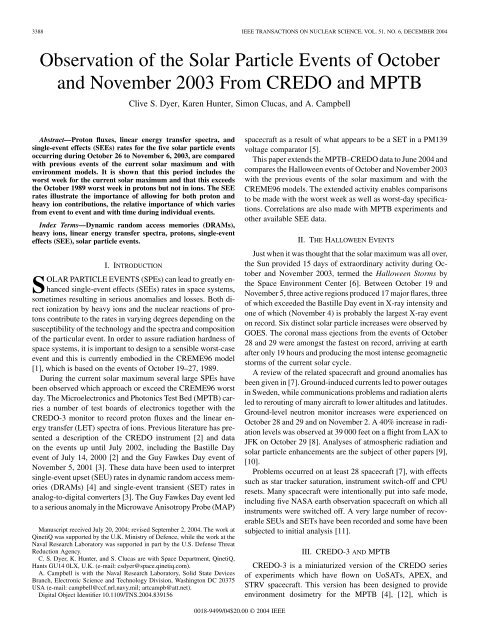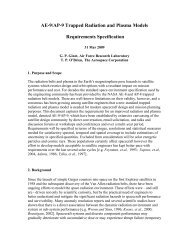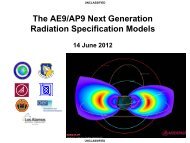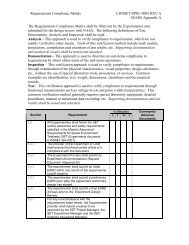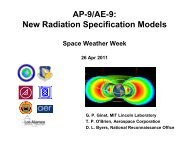Observation of the Solar Particle Events of October ... - IEEE Xplore
Observation of the Solar Particle Events of October ... - IEEE Xplore
Observation of the Solar Particle Events of October ... - IEEE Xplore
You also want an ePaper? Increase the reach of your titles
YUMPU automatically turns print PDFs into web optimized ePapers that Google loves.
3388 <strong>IEEE</strong> TRANSACTIONS ON NUCLEAR SCIENCE, VOL. 51, NO. 6, DECEMBER 2004<br />
<strong>Observation</strong> <strong>of</strong> <strong>the</strong> <strong>Solar</strong> <strong>Particle</strong> <strong>Events</strong> <strong>of</strong> <strong>October</strong><br />
and November 2003 From CREDO and MPTB<br />
Clive S. Dyer, Karen Hunter, Simon Clucas, and A. Campbell<br />
Abstract—Proton fluxes, linear energy transfer spectra, and<br />
single-event effects (SEEs) rates for <strong>the</strong> five solar particle events<br />
occurring during <strong>October</strong> 26 to November 6, 2003, are compared<br />
with previous events <strong>of</strong> <strong>the</strong> current solar maximum and with<br />
environment models. It is shown that this period includes <strong>the</strong><br />
worst week for <strong>the</strong> current solar maximum and that this exceeds<br />
<strong>the</strong> <strong>October</strong> 1989 worst week in protons but not in ions. The SEE<br />
rates illustrate <strong>the</strong> importance <strong>of</strong> allowing for both proton and<br />
heavy ion contributions, <strong>the</strong> relative importance <strong>of</strong> which varies<br />
from event to event and with time during individual events.<br />
Index Terms—Dynamic random access memories (DRAMs),<br />
heavy ions, linear energy transfer spectra, protons, single-event<br />
effects (SEE), solar particle events.<br />
I. INTRODUCTION<br />
SOLAR PARTICLE EVENTS (SPEs) can lead to greatly enhanced<br />
single-event effects (SEEs) rates in space systems,<br />
sometimes resulting in serious anomalies and losses. Both direct<br />
ionization by heavy ions and <strong>the</strong> nuclear reactions <strong>of</strong> protons<br />
contribute to <strong>the</strong> rates in varying degrees depending on <strong>the</strong><br />
susceptibility <strong>of</strong> <strong>the</strong> technology and <strong>the</strong> spectra and composition<br />
<strong>of</strong> <strong>the</strong> particular event. In order to assure radiation hardness <strong>of</strong><br />
space systems, it is important to design to a sensible worst-case<br />
event and this is currently embodied in <strong>the</strong> CREME96 model<br />
[1], which is based on <strong>the</strong> events <strong>of</strong> <strong>October</strong> 19–27, 1989.<br />
During <strong>the</strong> current solar maximum several large SPEs have<br />
been observed which approach or exceed <strong>the</strong> CREME96 worst<br />
day. The Microelectronics and Photonics Test Bed (MPTB) carries<br />
a number <strong>of</strong> test boards <strong>of</strong> electronics toge<strong>the</strong>r with <strong>the</strong><br />
CREDO-3 monitor to record proton fluxes and <strong>the</strong> linear energy<br />
transfer (LET) spectra <strong>of</strong> ions. Previous literature has presented<br />
a description <strong>of</strong> <strong>the</strong> CREDO instrument [2] and data<br />
on <strong>the</strong> events up until July 2002, including <strong>the</strong> Bastille Day<br />
event <strong>of</strong> July 14, 2000 [2] and <strong>the</strong> Guy Fawkes Day event <strong>of</strong><br />
November 5, 2001 [3]. These data have been used to interpret<br />
single-event upset (SEU) rates in dynamic random access memories<br />
(DRAMs) [4] and single-event transient (SET) rates in<br />
analog-to-digital converters [3]. The Guy Fawkes Day event led<br />
to a serious anomaly in <strong>the</strong> Microwave Anisotropy Probe (MAP)<br />
Manuscript received July 20, 2004; revised September 2, 2004. The work at<br />
QinetiQ was supported by <strong>the</strong> U.K. Ministry <strong>of</strong> Defence, while <strong>the</strong> work at <strong>the</strong><br />
Naval Research Laboratory was supported in part by <strong>the</strong> U.S. Defense Threat<br />
Reduction Agency.<br />
C. S. Dyer, K. Hunter, and S. Clucas are with Space Department, QinetiQ,<br />
Hants GU14 0LX, U.K. (e-mail: csdyer@space.qinetiq.com).<br />
A. Campbell is with <strong>the</strong> Naval Research Laboratory, Solid State Devices<br />
Branch, Electronic Science and Technology Division, Washington DC 20375<br />
USA (e-mail: campbell@ccf.nrl.navy.mil; artcampb@att.net).<br />
Digital Object Identifier 10.1109/TNS.2004.839156<br />
spacecraft as a result <strong>of</strong> what appears to be a SET in a PM139<br />
voltage comparator [5].<br />
This paper extends <strong>the</strong> MPTB–CREDO data to June 2004 and<br />
compares <strong>the</strong> Halloween events <strong>of</strong> <strong>October</strong> and November 2003<br />
with <strong>the</strong> previous events <strong>of</strong> <strong>the</strong> solar maximum and with <strong>the</strong><br />
CREME96 models. The extended activity enables comparisons<br />
to be made with <strong>the</strong> worst week as well as worst-day specifications.<br />
Correlations are also made with MPTB experiments and<br />
o<strong>the</strong>r available SEE data.<br />
II. THE HALLOWEEN EVENTS<br />
Just when it was thought that <strong>the</strong> solar maximum was all over,<br />
<strong>the</strong> Sun provided 15 days <strong>of</strong> extraordinary activity during <strong>October</strong><br />
and November 2003, termed <strong>the</strong> Halloween Storms by<br />
<strong>the</strong> Space Environment Center [6]. Between <strong>October</strong> 19 and<br />
November 5, three active regions produced 17 major flares, three<br />
<strong>of</strong> which exceeded <strong>the</strong> Bastille Day event in X-ray intensity and<br />
one <strong>of</strong> which (November 4) is probably <strong>the</strong> largest X-ray event<br />
on record. Six distinct solar particle increases were observed by<br />
GOES. The coronal mass ejections from <strong>the</strong> events <strong>of</strong> <strong>October</strong><br />
28 and 29 were amongst <strong>the</strong> fastest on record, arriving at earth<br />
after only 19 hours and producing <strong>the</strong> most intense geomagnetic<br />
storms <strong>of</strong> <strong>the</strong> current solar cycle.<br />
A review <strong>of</strong> <strong>the</strong> related spacecraft and ground anomalies has<br />
been given in [7]. Ground-induced currents led to power outages<br />
in Sweden, while communications problems and radiation alerts<br />
led to rerouting <strong>of</strong> many aircraft to lower altitudes and latitudes.<br />
Ground-level neutron monitor increases were experienced on<br />
<strong>October</strong> 28 and 29 and on November 2. A 40% increase in radiation<br />
levels was observed at 39 000 feet on a flight from LAX to<br />
JFK on <strong>October</strong> 29 [8]. Analyses <strong>of</strong> atmospheric radiation and<br />
solar particle enhancements are <strong>the</strong> subject <strong>of</strong> o<strong>the</strong>r papers [9],<br />
[10].<br />
Problems occurred on at least 28 spacecraft [7], with effects<br />
such as star tracker saturation, instrument switch-<strong>of</strong>f and CPU<br />
resets. Many spacecraft were intentionally put into safe mode,<br />
including five NASA earth observation spacecraft on which all<br />
instruments were switched <strong>of</strong>f. A very large number <strong>of</strong> recoverable<br />
SEUs and SETs have been recorded and some have been<br />
subjected to initial analysis [11].<br />
III. CREDO-3 AND MPTB<br />
CREDO-3 is a miniaturized version <strong>of</strong> <strong>the</strong> CREDO series<br />
<strong>of</strong> experiments which have flown on UoSATs, APEX, and<br />
STRV spacecraft. This version has been designed to provide<br />
environment dosimetry for <strong>the</strong> MPTB [4], [12], which is<br />
0018-9499/04$20.00 © 2004 <strong>IEEE</strong>
DYER et al.: OBSERVATION OF SPEs OF OCTOBER/NOVEMBER 2003 FROM CREDO AND MPTB 3389<br />
Fig. 1. Proton flux measurements from CREDO-3 on MPTB between November 1997 and June 2004 show <strong>the</strong> underlying cosmic-ray modulation with a minimum<br />
intensity in August 2000, toge<strong>the</strong>r with a number <strong>of</strong> very significant SPEs, seen as spikes, including <strong>the</strong> Halloween events <strong>of</strong> 2003.<br />
Fig. 2. Time variations <strong>of</strong> proton fluxes for <strong>the</strong> Halloween events. There are three orbits <strong>of</strong> missing data. For most <strong>of</strong> each orbit MPTB is fully exposed<br />
geomagnetically to solar particles but on ei<strong>the</strong>r side <strong>of</strong> perigee <strong>the</strong>re is geomagnetic screening, leading to <strong>the</strong> lowest levels and exposure to inner-belt protons,<br />
seen as spikes in <strong>the</strong> data.<br />
aimed at space testing a number <strong>of</strong> advanced technologies<br />
in a radiation-stressing, highly inclined elliptic orbit<br />
(39 200 1200 km) having a period <strong>of</strong> 12 hours. Results<br />
from CREDO up until July 2002, toge<strong>the</strong>r with an instrument<br />
description, have been presented in [2] and [3] while results on<br />
SEE are given in [3] and [4].<br />
The proton telescope measures fluxes <strong>of</strong> protons <strong>of</strong> energy<br />
greater than 38 MeV, while <strong>the</strong> ion monitor measures LET<br />
spectra in 16 channels which cover <strong>the</strong> range from 100 to<br />
20 000 MeV/(g cm ), with an upper channel providing an<br />
integral measurement above <strong>the</strong> higher level. These complementary<br />
measurements enable both proton-induced and<br />
ion-induced SEE to be quantified. Essentially continuous data<br />
coverage has been obtained from switch-on in November 1997<br />
until <strong>the</strong> present (July 2004) with <strong>the</strong> exception <strong>of</strong> a few periods<br />
<strong>of</strong> eclipses at around perigee and o<strong>the</strong>r minor data outages.<br />
IV. RESULTS<br />
A. Time Variations <strong>of</strong> Proton Fluxes<br />
The time variation in <strong>the</strong> proton fluxes is shown in Fig. 1 for<br />
<strong>the</strong> period from November 1997 to June 2004. The underlying,<br />
slowly varying level is from cosmic rays for which flux levels<br />
reached a minimum in August 2000 when <strong>the</strong>y were a factor 2.7<br />
lower than at <strong>the</strong> start <strong>of</strong> <strong>the</strong> mission. They have since recovered<br />
by a factor 1.5. The significant SPEs are seen as spikes lasting<br />
for several days each. Dates are given for <strong>the</strong> most significant<br />
increases, including <strong>the</strong> Halloween events. It can be seen that<br />
<strong>the</strong> event <strong>of</strong> <strong>October</strong> 28–29, 2003, is comparable to <strong>the</strong> largest<br />
<strong>of</strong> <strong>the</strong> previous events <strong>of</strong> this solar maximum. Unfortunately <strong>the</strong><br />
large SPE on November 9, 2000, was missed.<br />
The time pr<strong>of</strong>ile <strong>of</strong> <strong>the</strong> Halloween events is given in Fig. 2.<br />
Unfortunately three orbits <strong>of</strong> data were lost, one on <strong>October</strong> 29
3390 <strong>IEEE</strong> TRANSACTIONS ON NUCLEAR SCIENCE, VOL. 51, NO. 6, DECEMBER 2004<br />
Fig. 3. Integral LET spectrum under 6 mm <strong>of</strong> equivalent aluminum shielding<br />
for <strong>the</strong> fully exposed portion <strong>of</strong> orbit 4377 during <strong>the</strong> peak <strong>of</strong> <strong>the</strong> <strong>October</strong> 28<br />
event, compared with <strong>the</strong> pre-event spectrum and <strong>the</strong> CREME96 worst-day<br />
model.<br />
Fig. 5. Integral LET spectrum under 6 mm <strong>of</strong> equivalent aluminum shielding<br />
for orbit 4387 during <strong>the</strong> November 2 event.<br />
Fig. 4. Integral LET spectrum under 6 mm <strong>of</strong> equivalent aluminum shielding<br />
for orbit 4380 on <strong>October</strong> 30, 2003.<br />
and two on November 1. Five distinct solar particle increases are<br />
discernible at this energy ( 38 MeV) with start dates <strong>of</strong> <strong>October</strong><br />
26, <strong>October</strong> 28, <strong>October</strong> 29, November 2, and November 4. The<br />
largest event is that <strong>of</strong> <strong>October</strong> 28, while <strong>the</strong> event <strong>of</strong> November<br />
4 is significantly less intense in protons although it is <strong>the</strong> most<br />
intense in X-rays. This could in part be due to its location on<br />
<strong>the</strong> western limb <strong>of</strong> <strong>the</strong> Sun where connection to <strong>the</strong> Earth via<br />
<strong>the</strong> interplanetary magnetic field is less favorable compared with<br />
optimum heliolongitudes around 40 to 50 west. The considerable<br />
structure seen every 12 hours is due to <strong>the</strong> trapped protons<br />
seen as spikes in <strong>the</strong> data on ei<strong>the</strong>r side <strong>of</strong> perigee and <strong>the</strong> geomagnetic<br />
screening <strong>of</strong> solar particles in <strong>the</strong> same region, leading<br />
to <strong>the</strong> lowest levels. For <strong>the</strong> rest <strong>of</strong> <strong>the</strong> orbit <strong>the</strong>re is almost total<br />
exposure to cosmic rays and SPEs [2].<br />
B. Integral LET Spectra<br />
The integral LET spectra for various orbits during <strong>the</strong>se<br />
events are compared with <strong>the</strong> CREME96 worst-day spectrum<br />
in Figs. 3–6. The first gives <strong>the</strong> peak spectrum on <strong>October</strong><br />
28–29 (1520 to 0234 UT), while <strong>the</strong> second gives <strong>the</strong> spectrum<br />
for <strong>October</strong> 30 (0233-1506 UT) during <strong>the</strong> decay phase <strong>of</strong> <strong>the</strong><br />
<strong>October</strong> 29 SPE. Unfortunately <strong>the</strong> orbit (4379) during <strong>the</strong><br />
Fig. 6. Integral LET spectrum under 6 mm <strong>of</strong> equivalent aluminum shielding<br />
for orbit 4392 during <strong>the</strong> November 4–5 event.<br />
peak <strong>of</strong> this event suffered data loss. Fig. 5 gives <strong>the</strong> spectrum<br />
for <strong>the</strong> peak <strong>of</strong> <strong>the</strong> November 2 event (1455–0211 UT), while<br />
Fig. 6 gives <strong>the</strong> peak <strong>of</strong> <strong>the</strong> November 4 event (0204–1438 UT<br />
on November 5). Note that in <strong>the</strong> last case <strong>the</strong> statistics <strong>of</strong> <strong>the</strong><br />
high LET increase are extremely poor and <strong>the</strong> apparent upturn<br />
is not considered real. The CREME96 worst-day predictions<br />
used throughout correspond to 6 mm <strong>of</strong> aluminum shielding,<br />
equivalent to that covering <strong>the</strong> CREDO-3 detector. The <strong>October</strong><br />
28, 2003, event is very comparable to <strong>the</strong> CREME96 worst day,<br />
slightly exceeding it at low LET, while <strong>the</strong> succeeding events<br />
are progressively lower. Unfortunately <strong>the</strong> peak <strong>of</strong> <strong>the</strong> <strong>October</strong><br />
29 event was not measured.<br />
C. Comparison With O<strong>the</strong>r <strong>Events</strong> and Models<br />
In Fig. 7 <strong>the</strong> integral LET spectrum for <strong>the</strong> event <strong>of</strong> <strong>October</strong><br />
28, 2003, is compared with <strong>the</strong> events <strong>of</strong> July 14, 2000, April<br />
15, 2001, and November 5, 2001. Three <strong>of</strong> <strong>the</strong> events exceed<br />
CREME96 at low LET where protons dominate. Note that <strong>the</strong><br />
orbit given for <strong>the</strong> July 14, 2000, event is that for <strong>the</strong> peak proton<br />
flux (orbit 1968) and that for this event <strong>the</strong> ions peaked earlier<br />
(orbit 1967) at which time <strong>the</strong>y matched <strong>the</strong> CREME96<br />
high LET spectrum [3]. The events <strong>of</strong> <strong>October</strong> 28, 2003, and
DYER et al.: OBSERVATION OF SPEs OF OCTOBER/NOVEMBER 2003 FROM CREDO AND MPTB 3391<br />
TABLE I<br />
MEASURED PROTON FLUENCES >38 MeV cf. CREME96 MODEL<br />
Fig. 7. Integral LET spectrum under 6 mm <strong>of</strong> equivalent aluminum shielding<br />
at <strong>the</strong> peak <strong>of</strong> <strong>the</strong> <strong>October</strong> 28, 2003, event is compared with <strong>the</strong> previous largest<br />
events <strong>of</strong> this solar maximum and with <strong>the</strong> CREME96 worst day.<br />
Fig. 8. One-week rolling averages during <strong>the</strong> period <strong>October</strong> 26, 2003, to<br />
November 6, 2003, are compared with <strong>the</strong> CREME96 worst-week model.<br />
November 5, 2001, have significant heavy ions but are somewhat<br />
below CREME96, while <strong>the</strong> April 15, 2001, event is <strong>the</strong><br />
most intense in heavy ions despite being significantly less intense<br />
in protons.<br />
The occurrence <strong>of</strong> several successive events over <strong>the</strong> course <strong>of</strong><br />
a week or so during <strong>the</strong> Halloween events is a very comparable<br />
situation to that <strong>of</strong> <strong>October</strong> 19–27, 1989, which was used to<br />
create <strong>the</strong> CREME96 worst-week specification. Spectra from<br />
worst weeks around <strong>the</strong> previous events <strong>of</strong> this solar maximum<br />
have all fallen below <strong>the</strong> CREME96 worst week as <strong>the</strong>y have<br />
been isolated events [3].<br />
In Fig. 8 <strong>the</strong> one-week averages for various starting dates<br />
during <strong>the</strong> Halloween events are compared with <strong>the</strong> CREME96<br />
worst week. These have some missing data and are hence lower<br />
limits. The CREME96 worst week is significantly exceeded at<br />
low LET but exceeds <strong>the</strong> latest events at high LET. The low LET<br />
result has been checked using <strong>the</strong> proton monitor with interpolation<br />
over missing orbits and <strong>the</strong> fluences over <strong>the</strong> major events<br />
<strong>of</strong> this solar maximum are presented in Table I. The worst-week<br />
fluence for <strong>the</strong> Halloween week is cm compared<br />
with cm for CREME96. The week <strong>of</strong> November<br />
5–11 is higher but this is highly dependent on interpolated data.<br />
The total measured solar proton fluence greater than 38 MeV<br />
for this solar maximum based on 6.6 years <strong>of</strong> CREDO data is<br />
cm . This does not include <strong>the</strong> event <strong>of</strong> November<br />
9, 2000, which could have added about cm based<br />
on GOES data. It is interesting to note that this total is very<br />
comparable with <strong>the</strong> fluence <strong>of</strong> cm obtained from<br />
<strong>the</strong> JPL-91 model [13] for seven years at solar maximum at<br />
<strong>the</strong> 90% confidence level, calling into question whe<strong>the</strong>r this is<br />
sufficiently conservative. The Emission <strong>of</strong> <strong>Solar</strong> Protons (ESP)<br />
model [14] gives a fluence <strong>of</strong> cm for <strong>the</strong> same<br />
conditions.<br />
It is also <strong>of</strong> interest to compare <strong>the</strong> results <strong>of</strong> Table I with<br />
<strong>the</strong> ESP worst-case event model. For <strong>the</strong> 90% confidence level<br />
this gives worst-case event fluences above 40 MeV <strong>of</strong><br />
cm for a one-year mission and cm for a<br />
seven-year mission. It should be borne in mind that an event<br />
lasts more than one day (typically two) and so <strong>the</strong> CREME96<br />
model is consistent with <strong>the</strong> one-year 90% ESP case. It is also<br />
worth noting that <strong>the</strong> anomalously large event used in <strong>the</strong> King<br />
model and based on <strong>the</strong> event <strong>of</strong> August 1972 gives an event<br />
fluence <strong>of</strong> cm . The MPTB/CREDO-3 data taken<br />
over nearly seven years are consistent with <strong>the</strong> ESP model and<br />
suggest that this model should be employed for proton-induced<br />
SEE using <strong>the</strong> confidence level desired by <strong>the</strong> project.<br />
D. Correlation With Effects<br />
SEEs have been observed in <strong>the</strong> MPTB experiments during<br />
<strong>the</strong>se events and Fig. 9 shows <strong>the</strong> total upset rates observed<br />
during <strong>the</strong> period September 20 to November 5, 2003, in four<br />
16-Mbit NEC DRAMs on board B6 <strong>of</strong> MPTB. The devices used<br />
are those facing into <strong>the</strong> spacecraft as those facing out are experiencing<br />
too much leakage current due to <strong>the</strong> accumulated dose.<br />
The large increase in upset rates during <strong>the</strong> events <strong>of</strong> <strong>October</strong><br />
28 and 29 can be readily seen. In Table II <strong>the</strong> upset rates are<br />
compared with those during previous events and CREDO measurements<br />
<strong>of</strong> proton fluences 38 MeV and ion fluences <strong>of</strong> LET<br />
1.82 MeV/(mg cm ). The results are plotted as histograms<br />
in Fig. 10. All rates and fluences are per device and per orbit<br />
(i.e., 12 hours). The average upset rate for <strong>the</strong> peak day <strong>of</strong> <strong>the</strong><br />
<strong>October</strong> 28–29 events is 179 per device-day compared with a<br />
quiet-time rate <strong>of</strong> 3.1 per device day from galactic cosmic rays<br />
and inner-belt protons. This may be compared with a peak day<br />
rate <strong>of</strong> 225 per device-day during <strong>the</strong> Bastille Day event. A previous<br />
detailed analysis <strong>of</strong> SEU rates during <strong>the</strong> Bastille Day<br />
event showed that in <strong>the</strong> light <strong>of</strong> CREDO measurements and<br />
measured proton and ion cross-sections, <strong>the</strong> ratio <strong>of</strong> ion-induced<br />
to proton-induced upsets was about 2:1 [7]. Note that during<br />
<strong>the</strong> <strong>October</strong> 2003 events <strong>the</strong> fluxes <strong>of</strong> both protons and heavy
3392 <strong>IEEE</strong> TRANSACTIONS ON NUCLEAR SCIENCE, VOL. 51, NO. 6, DECEMBER 2004<br />
Fig. 9.<br />
Upset rates in four 16-Mbit DRAMs on MPTB for <strong>the</strong> time period September 22 to November 5, 2003, showing <strong>the</strong> increases from <strong>the</strong> Halloween events.<br />
TABLE II<br />
UPSET RATES IN DRAMS FOR MAJOR SPEs cf. CREDO<br />
PROTON AND ION FLUENCES<br />
Fig. 10. Proton and ion fluences per 12-hour orbit from CREDO-3 on MPTB<br />
compared with SEUs per 16-Mbit DRAM.<br />
ions were simultaneously elevated, whereas during <strong>the</strong> Bastille<br />
Day event <strong>the</strong> peaks occurred at different times. The SEU rates<br />
during <strong>the</strong> events <strong>of</strong> November 2 and 4, 2003, are relatively low.<br />
These data show <strong>the</strong> worst orbit for SEU to be 2929 on<br />
November 5–6, 2001, when both protons and ions were simultaneously<br />
high. Comparison <strong>of</strong> orbits 1968 (July 14–15,<br />
2000) and 4378 (<strong>October</strong> 29, 2003) shows that particle fluxes<br />
were comparable but that SEU rates were different by a factor<br />
two. O<strong>the</strong>r factors such as spectral hardness are probably<br />
responsible.<br />
SEU data from <strong>the</strong> solid state recorder (SSR) carried on <strong>the</strong><br />
Orbview-2 mission have been analyzed in [15] in which upsets<br />
during <strong>the</strong> major SPEs occurring between July 14, 2000,<br />
and April 21, 2002, were compared with proton fluxes measured<br />
by GOES. The SSR comprised 512 Mbit <strong>of</strong> memory provided<br />
by 4-Mbit MOSAIC/HITACHI DRAMs (MDM1400G-<br />
120) and protected by Hamming Error Detection and Correction<br />
Code. The orbit was a circular 750 km altitude, 98 inclination,<br />
and sun-synchronous for which <strong>the</strong> high latitude portions<br />
<strong>of</strong> each orbit are vulnerable to SPEs. Additional data up<br />
until November 2003 have recently been provided [11]. These<br />
extended data have now been compared with proton and ion fluences<br />
from CREDO-3 on MPTB and <strong>the</strong> results are presented<br />
in Fig. 11. The LET threshold for ions is again 1.82 MeV/(mg<br />
cm ) and this corresponds well with <strong>the</strong> threshold reported in<br />
[15]. It can be seen that <strong>the</strong> correlation with particle fluences is<br />
again complex and that both ions and protons are contributing
DYER et al.: OBSERVATION OF SPEs OF OCTOBER/NOVEMBER 2003 FROM CREDO AND MPTB 3393<br />
V. CONCLUSION<br />
For <strong>the</strong> current solar maximum <strong>the</strong>re are now four events<br />
which have shown worst-day LET spectra that are very close<br />
to and possibly exceed <strong>the</strong> CREME96 worst-day model. For<br />
three events (July 14, 2000, November 5, 2001, and <strong>October</strong><br />
28, 2003) <strong>the</strong> proton fluxes and heavy-ion component are both<br />
comparable to <strong>the</strong> model, although not necessarily at <strong>the</strong> same<br />
time (for example <strong>the</strong> July 14, 2000, event showed ion fluxes<br />
peaking before proton fluxes). For <strong>the</strong> event <strong>of</strong> April 15, 2001,<br />
only <strong>the</strong> heavy-ion component is comparable with CREME96.<br />
The CREME96 worst week has been exceeded in protons by<br />
<strong>the</strong> worst Halloween week as well as possibly <strong>the</strong> worst weeks<br />
<strong>of</strong> July 2000 and November 2001. However, it remains worst<br />
case in heavy ions.<br />
The worst-event and mission-integrated fluences <strong>of</strong> protons<br />
are consistent with <strong>the</strong> ESP [14] model and it may be preferable<br />
to use this to assess proton-induced upsets.<br />
The extreme variability <strong>of</strong> <strong>the</strong>se events implies that SEE rates<br />
can be interpreted only in <strong>the</strong> light <strong>of</strong> measured proton fluxes<br />
and ion LET spectra, <strong>the</strong> relative importance <strong>of</strong> which can vary<br />
even within an event. Additional factors, such as particle spectra<br />
and device shielding, must also be taken into account.<br />
Some devices are susceptible only to ions and it is important<br />
to know which SPEs contain a significant fraction <strong>of</strong> ions. Interestingly<br />
<strong>the</strong> MAP SET anomaly did not reoccur during <strong>the</strong><br />
Halloween events despite <strong>the</strong> high LET spectrum being comparable<br />
to <strong>the</strong> November 5, 2001, event. As probabilities during a<br />
worst day are calculated to be about 0.5 per day this is probably<br />
due to <strong>the</strong> limited statistics [11].<br />
ACKNOWLEDGMENT<br />
The authors would like to thank C. Poivey, J. Barth, and K.<br />
LaBel <strong>of</strong> NASA/Goddard Space Flight Center for information<br />
concerning MAP and <strong>the</strong> Orbview-2 data. The solar proton fluences<br />
from <strong>the</strong> JPL-91, King, and ESP models were obtained<br />
using <strong>the</strong> SPENVIS website (spenvis@oma.be).<br />
Fig. 11. Proton and ion fluences per day from CREDO-3 on MPTB are<br />
compared with SEU data from <strong>the</strong> Orbview-2 SSR.<br />
in varying degrees from event to event. For example, as in <strong>the</strong><br />
MPTB DRAMs, <strong>the</strong> SEU rate drops between July 14 and 15,<br />
2000, while <strong>the</strong> proton flux increases. This is probably due to<br />
<strong>the</strong> decreasing ion flux that was noted above, although changes<br />
in proton spectra could also be a contributory factor.<br />
REFERENCES<br />
[1] A. J. Tylka, J. H. Adams Jr., P. R. Boberg, B. Brownstein, W. F. Dietrich,<br />
E. O. Flueckiger, E. L. Petersen, M. A. Shea, D. F. Smart, and E. C.<br />
Smith, “CREME96: A revision <strong>of</strong> <strong>the</strong> cosmic ray effects on microelectronics<br />
code,” <strong>IEEE</strong> Trans. Nucl. Sci., vol. NS-44, pp. 2150–2160, Dec.<br />
1997.<br />
[2] C. S. Dyer, P. R. Truscott, C. Sanderson, C. Watson, C. L. Peerless, P.<br />
Knight, R. Mugford, T. Cousins, and R. Noulty, “Radiation environment<br />
measurements from CREAM & CREDO during <strong>the</strong> approach to solar<br />
maximum,” <strong>IEEE</strong> Trans. Nucl. Sci., vol. 47, pp. 2208–2217, Dec. 2000.<br />
[3] C. S. Dyer, K. Hunter, S. Clucas, D. Rodgers, A. Campbell, and S.<br />
Buchner, “<strong>Observation</strong>s <strong>of</strong> solar particle events from CREDO and<br />
MPTB during <strong>the</strong> current solar maximum,” <strong>IEEE</strong> Trans. Nucl. Sci., vol.<br />
49, pp. 2771–2775, Dec. 2002.<br />
[4] A. Campbell, S. Buchner, E. Petersen, J. B. Blake, J. Mazur, C. Dyer,<br />
and P. Marshall, “SEU measurements and predictions on MPTB for<br />
an energetic solar particle event,” <strong>IEEE</strong> Trans. Nucl. Sci., vol. 49, pp.<br />
1340–1345, June 2002.<br />
[5] C. Poivey, J. L. Barth, J. McCabe, and K. A. Label, “A space wea<strong>the</strong>r<br />
event on <strong>the</strong> microwave anisotropy probe,” in Proc. Workshop Radiation<br />
and Its Effects on Components Systems (RADECS2002), Sept. 2002, pp.<br />
43–46.<br />
[6] NOAA Space Environment Center User Notes, no. 43, Jan. 2004.<br />
[7] D. F. Webb and J. H. Allen, “Spacecraft and ground anomalies related to<br />
<strong>the</strong> <strong>October</strong>–November 2003 solar activity,” Space Wea<strong>the</strong>r Quart., pp.<br />
6–8, Summer 2004.<br />
[8] I. L. Getley, “<strong>Observation</strong> <strong>of</strong> solar particle event on board a commercial<br />
flight from Los Angeles to New York on 29 <strong>October</strong> 2003,” Space<br />
Wea<strong>the</strong>r Quarterly, vol. 2, pp. 9–15, Fall 2004, to be published.<br />
[9] F. Lei, S. Clucas, C. Dyer, and P. Truscott, “An atmospheric radiation<br />
model based on response matrices generated by detailed Monte Carlo<br />
simulations <strong>of</strong> cosmic ray interactions,” <strong>IEEE</strong> Trans. Nucl. Sci., vol. 51,<br />
Dec. 2004.<br />
[10] S. N. Clucas, C. S. Dyer, and F. Lei, “The radiation in <strong>the</strong> atmosphere<br />
during major solar particle events,” presented at <strong>the</strong> 35th Committee<br />
on Space Research Scientific Assembly (COSPAR2004), Paris, France,<br />
July 18–25, 2004.<br />
[11] C. Poivey, H. Safren, G. Gee, K. LaBel, and J. Barth, “<strong>Observation</strong> <strong>of</strong><br />
solar particle events from in-flight data,” presented at <strong>the</strong> 2004 Single<br />
Event Effects Symp., Los Angeles, CA, Apr. 27–29, 2004.<br />
[12] J. C. Ritter, “Microelectronics and photonics test bed,” in Proc. 20th<br />
Annu. American Aeronautical Society (AAS) Guidance Control Conf.,<br />
1997.<br />
[13] J. Feynman, G. Spitale, J. Wang, and S. Gabriel, “Interplanetary<br />
proton fluence model: JPL 1991,” J. Geophys. Res. 98, vol. A8, pp.<br />
13 281–13 294, 1993.<br />
[14] M. A. Xapsos, J. L. Barth, E. G. Stassinopoulos, and E. A. Burke, “Probability<br />
model for cumulative solar proton event fluences,” <strong>IEEE</strong> Trans.<br />
Nucl. Sci., vol. 47, pp. 486–490, June 2000.<br />
[15] C. Poivey, J. L. Barth, K. A. LaBel, G. Gee, and H. Safren, “In-flight observations<br />
<strong>of</strong> long-term single-event effect (SEE) performance on Orbview-2<br />
solid state recorder (SSR),” in 2003 <strong>IEEE</strong> Radiation Effects Data<br />
Workshop Record, 2003, pp. 102–107.


